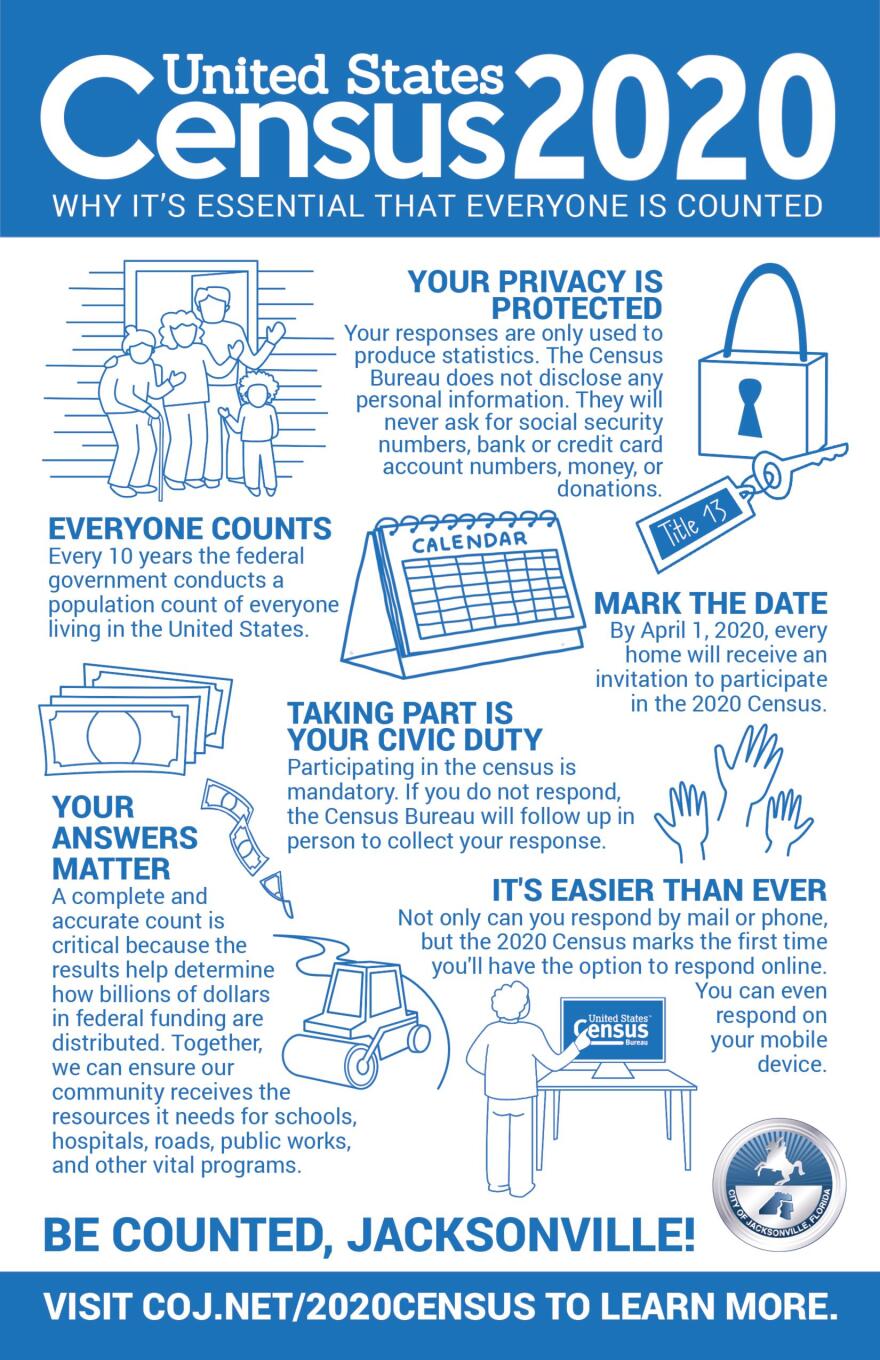Florida has been identified as a high-risk state when it comes to getting its fair share of federal money in the coming years.
That’s according to a 2019 research paper from the Urban Institute, which is predicting the state’s population will be undercounted in the 2020 Census, which begins April 1.
To combat the issue, Governor Ron DeSantis announced a state-wide Complete Count Committee to get more people to complete the Census.
At the local level, Northeast Florida counties are creating their own Complete Count Committees to reach out to local leaders and organizations.
“Whether it’s the Hispanic Advisory Board of the Disability Council, the Housing Authority, there are lots of different boards and commissions that the city works [with],” said Dawn Lockhart, the director of strategic partnerships for Jacksonville Mayor Lenny Curry.
She was charged with forming the Duval County Complete Count Committee.
The goal is to reach hard-to-count populations and more accurately understand Florida’s overall population. In turn, the state would receive more of the $675 billion in federal funding to be dished out to states.
Demographic groups like minorities, veterans, senior citizens, low-income individuals and the homeless are less likely to be accounted for in the census, according to Lockhart.

The George Washington Institute of Public Policy researched census undercounts and found that for every citizen not properly counted, roughly $14,450 in federal funding over the next decade will be missed out on.
Lockhart said Duval County has been recognized by the Federal Census Bureau for the work its done engaging with the community. She said about 800 organizations have joined the effort as ambassadors to take part in Census awareness.
The county has also used the Mayor’s Young Leaders Advisory Council, which consists of high schoolers from each school in the community, to educate youth on the importance of the census that they can share with their families and members of their community.
“They can’t take part in the Census themselves, they can’t complete it, but they count,” Lockhart said. “By using their leadership skills within their high schools and communicating to other youth and their own families and in their own neighborhoods, they are already beginning to activate their voice in the civic engagement process in our society.”
St. Johns County created its own Complete Count Committee as well, chaired by County Commissioner James K. Johns.
“It provides uniformity at the local level,” Johns said of the committee. “We understand the culture of our community, and the individuals that are likely to be most effective and encouraging our residents to participate.”
Johns said the state money received by this federal funding can still be recognized at a local level.
“Whether it's quality of life items, like our school systems, like our infrastructure, on a large scale basis, our expressways,” Johns expressed. “Not the items that are funded locally, but the items that, frankly, cost too much for an individual community to be able to pay for at one time. We pay to the government over years, and this is a way of getting that money back in large chunks.”
In Clay County, the Complete Count Committee is run by county Public Information Officer Annaleasa Winter. She’s created a committee of about two dozen public information officers across the county to communicate to different organizations.
“We also want to make sure that our citizens have the representation that they need in the House of Representatives,” Winter said.
With a large population spike in the state projected by the U.S. Census Bureau, Florida is likely to gain a pair of congressional seats with an outside chance at a third.
Winter said the committee will identify places where people can easily access the Census. Kiosks will be available in local library branches to complete the form.
“People that don’t have internet access or don’t typically use social media, you’ve got to provide those materials somewhere where they can see them,” Winter said. “So that means getting out there, identifying business locations to put up posters.”
Baker County created a Complete Count Committee consisting of town and church leaders in the area.
While a higher census count means more money for the state, Lockhart believes it also has implications for local economies.
“Business relocations,” Lockhart said. “A company that is looking at the census data for Jacksonville to determine whether they want to relocate their business to Jacksonville, they're looking right now at 2010 census data. Jacksonville has changed significantly since 2010.”
The Complete Count Committees are using separate strategies from U.S. Census Bureau employees who will be knocking on doors and spreading local awareness in upcoming weeks.
The U.S. Census Bureau will begin visiting homes that haven’t responded to the 2020 Census from May through July.
Sky Lebron can be reached at slebron@wjct.org, 904-358-6319 or on Twitter at @SkylerLebron.




